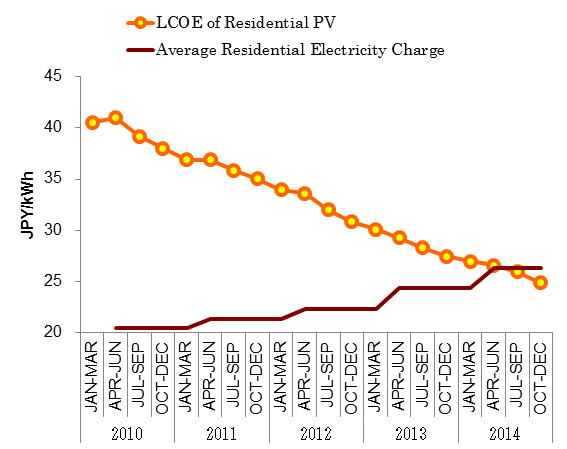Grid Parity – Solar PV Has Caught Up with Japan’s Grid Electricity in Japanese
There is a claim that solar PV is high in cost. For example, the cost of electricity from residential solar PVs was estimated at 29.4 yen/kWh by a government committee (Power Generation Cost Verification Working Group under the Advisory Committee for Natural Resources and Energy) in May 2015. Unit cost of power generation was assessed to be at least twice as high for solar PV compared to that for LNG thermal power, the major energy source in Japan, which is 13.7 yen/kWh.
However, it is inadequate to simply assess economic efficiencies of energy sources like residential solar PVs or CHPs, so called on-site generations, which are installed at sites where power is consumed, and energy sources that are installed far away from places where power is consumed, by comparing unit costs of power generation alone because the power is not consumed where it is generated in the latter case.
In Japan, the electricity we use is suplied from power plants via grid systems owned by regional big power companies (utilities). The cost of transmission and distribution is a cost that occurs separately. This cost, based on the statement of accounts of the utilities, was 3.3 yen/kWh in fiscal year 2014. In addition, various other expenses and taxes of the utilities amount to approximately 2.8 yen/kWh. Hence, the total additional cost aside from cost of power generation is 6.1 yen/kWh. Electricity bills charged to consumers ultimately include these various costs as well as the profit for the utilities.
When a person privately installs a solar PV system at residence, no cost for transmission or distribution is required if the electricity is consumed directly at the site, and no payment is required to utilities either, as the power is not purchased through them. It means that the cost for using electricity generated by solar PV is comprised only of the installation and maintenance costs of the solar PV system.
In assessing the economic efficiency of a residential solar PV system, any comparison of the unit cost of power generation with other energy sources is meaningless for a person who is installing such a system, but comparison by electricity rate for households is more practical. Those installing residential solar PV systems will be better off if the cost incurred by installing them is cheaper than the electricity rate they have to pay when they purchase electricity from utilities.
So we estimated the cost of electricity from residential solar PV in recent years and compared the figures with electricity rate (See the diagram). We presented a similar comparison in the earlier article on 4th December 2014, but this time we have revised the interest rate (discount rate) to match the reality. According to the current estimate, the cost of electricity from residential solar PV was 40 yen/kWh or so in around 2010, which was indeed twice as high when compared to the electricity rate, but the cost has continued to fall since. By the period from July to September 2014, the cost reached 26.0 yen/kWh, which was lower than the average electricity rate of the same year, which was 26.3 yen/kWh. The unit cost of power generation continued to fall and reached 24.9 yen/kWh by the period from October to December 2014. From these figures, we can assume with high probability that the cost of residential solar PV has become cheaper than the electricity rate in the latter half of 2014.
The above is based on the assumption that the electricity rate will remain constant for the next 20 years, however, there are many uncertainties about the cost of energy, as the risk assessment of nuclear accidents has become stringent, and there is also a fluctuation risk concerning costs of fossil fuels. Installation of a solar PV system is not only economically attractive to those installing it, but also helps them to reduce such uncertainties.
The cost of electricity from solar PV is already lower than electricity rates in some parts of the world. According to Grid Parity Monitoring (2015), Germany, Italy, Spain, Australia, Israel and Mexico already reached such levels between 2011 and 2012. Japan has caught up with the rest of the world at last.

Diagram Cost of electricity from solar PV and the average rate of electricity
Note: Cost of electricity from residential solar PV is the cost for generating 1 kWh of power, calculated based on the assumption that the system will be used for 20 years, and including the costs of equipment and maintenance, interest rate (discount rate), and other costs. In determining the cost of equipment, reference was made to the number of residential solar PV systems granted subsidies presented by the Japan Photovoltaic Expansion Center under the Japan Photovoltaic Energy Association. We assumed a 3.2% discount rate in our earlier article (“Solar rooftop PV may outcompete Japan’s grid electricity in 2015,” 4 December 2014), but this time we calculated the weighted average cost of capital and used that figure (1.7%) to better reflect the reality. In doing so, we used the figure 38% for owner’s equity to total assets, referring to the figure for a house built to order in the Report on the Survey of Housing Market Trends published by the Ministry of Land, Infrastructure, Transport and Tourism (MLIT) in 2014. For interest rate on loans, reference was made to the interest rate for mortgage loan in the Bank of Japan’s Financial and Economic Statistics Monthly (2.475%). For the return on equity, we used the rate of return for newly issued 10-year government bonds mentioned in the same document (0.32%). Electricity rate per unit was calculated by dividing the revenue from electricity charges for the ten utilities by the amount of electricity sold.
References
・Briano, J. L., Baez, M. J., and R. M. Morales, (2015) PV Grid Parity Monitor: Residential Sector, 3rd issue, CREARA.

